S19-Wk4: Data-sheet for NPN and PNP Transistor measurements
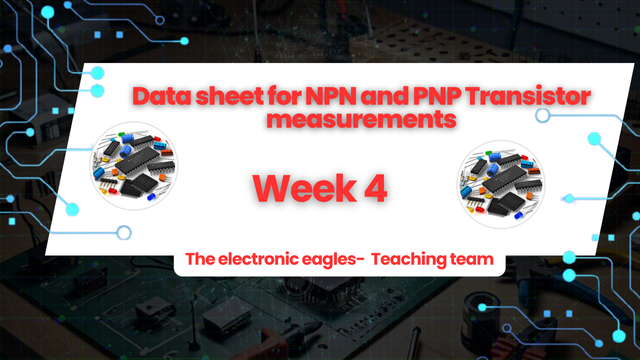
Hi students welcome to Electronics Lesson 4.
If you have reached this stage it is because you are interested in learning, you already have a clearer notion about electronics and a projection of where we want to go.
In Lesson 1 we defined what a transistor is and mentioned the different types. In lesson 2 we started working with some component measurements, but we did not touch transistors, in lesson 3 we started reading diagrams and assembling small circuits.
Now, in lesson 4, we will study the most basic and practical of the BJT type transistors (Bipolar Junction Transistor) this type of transistors are very common and used in most electronic circuits.
nical circuits.

There are NPN and PNP types, but at first glance they all seem to be the same, however they have an identification or nomenclature that will help us to identify them by means of the data sheet or Data sheet.
What is an electronic data sheet?
It is a detailed technical summary of a specific electronic component. Each manufacturer of electronic components makes available to us technical data sheets of their products so that we can know all their characteristics and operating parameters.
Usually when we find a transistor that gives us some doubtful measurements or that is faulty, we put its nomenclature in Google together with the word datasheet and when we press enter, the search engine gives us many results.
The technician will be able to select the correct option taking into account his knowledge of the physical structure of the transistor to be studied.
NPN and PNP Transistor Measurement
In order to make sure that we are taking correct measurements with our multimeter, we must know the identification of the transistor legs. That is, B, C, E and the type of transistor.
This information is found in the data sheet, so it is important to search for it.

Now we can know where to place the tips of our multimeter to take the measurements.
If our transistor is NPN, then the Base is positive, so we must place our multimeter in diode scale and place the positive tip on the Base.
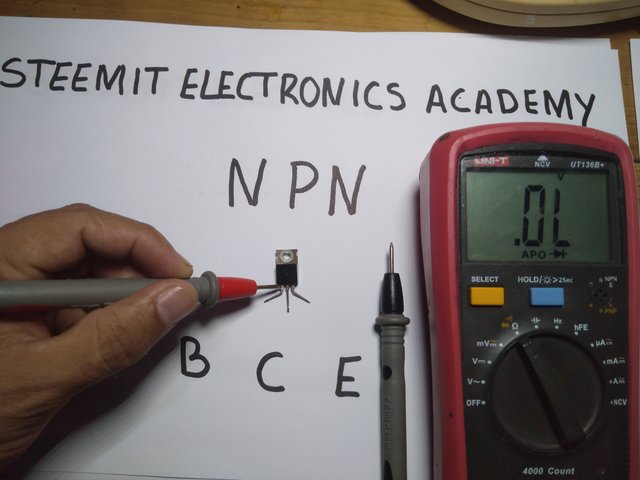
Now with the black probe we will touch the Collector. When doing so we should see in our multimeter a reading of diode.
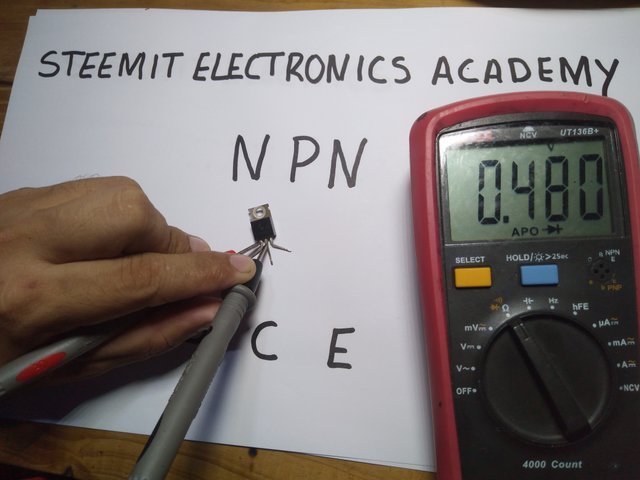
Then holding the red tip on the base, we proceed to touch the Emitter, here we should see another diode measurement, not too far away from the first measurement.
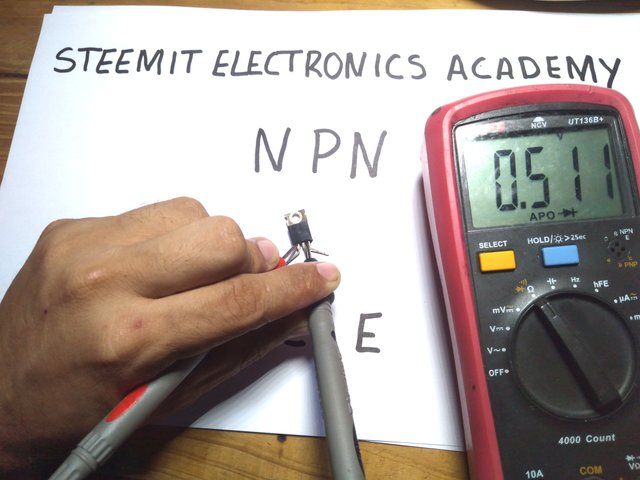
We could say that this transistor is in good condition, however we must corroborate it by making a third measurement, which consists of touching the red probe on Collector and the black probe on Emitter and vice versa just like we see below:
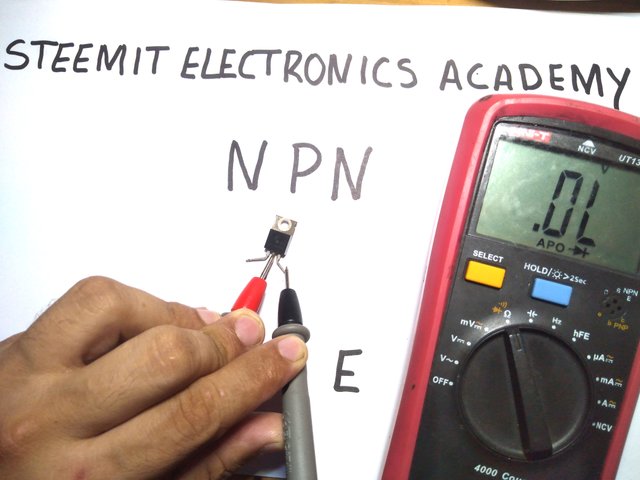
When doing so, no measurement should be shown, otherwise the transistor is leaking, i.e. it is damaged.
This same operation is performed with PNP transistors, but instead of placing the red tip at the base of the transistor, the Black tip is placed.
Assignment
With these explanations in mind, we would like you to complete the following tasks:
Task 1:
Find the data sheet for the following nomenclatures.
Irfz24A
N5551
(Draw the component and identify the legs of each one of them, observe if there is a difference between them, mention it.)
Task 2:
Find the data sheet for the following transistors.
MJE 13003
PHE 13003C
Tip41
Indicate which among these transistors that can serve as replacements for each other and Why?
Locate NPN or PNP type transistor at home, identify its legs as explained in the class and perform the 3 measurements. Determine if the transistor is in good condition or not.
Instructions :
- Please kindly read all the instructions we have on our post entitled: Reminders For Students in Electronics Academy. We would be working with those instructions STRICTLY

The participation schedule is between Monday, July 29 , 2024 at 00:00 UTC to Sunday, - August 4, 2024 at 23:59 UTC.
DO NOT wait till the last minutes to submit and create unnecessary arguments about time zone, you have the whole week to do your tasks., use it
Feel free to post in any language hence it can be translated on google translator
Please make sure to include our tag #electronicss19w4 among your first four tags for easy search.
You must take clear pictures, you can seek the help of a person to take your pictures, but it is you who must take the measurements.
Post the link of your assignment in the comment section of this lesson.
Avoid unnecessary long and irrelevant introductory
All our instructions are supper important and all participating students are advised to read and understand those rules/regulations.

Note to community curators:
Please NO community curator should use the SC account to vote any assignment in the "Electronic Academy" when such post is not verified yet by any of the professors.
Note to students:
Additional efforts will be taken into account , so try to be creative , original and show your interest in learning .
This lesson is more of practical because we are heading to somewhere. If you have completed all the tasks, please kindly wait for the professor's comments and continue studying to be prepared for the third week.
Goodluck
The Electronic Eagles Team
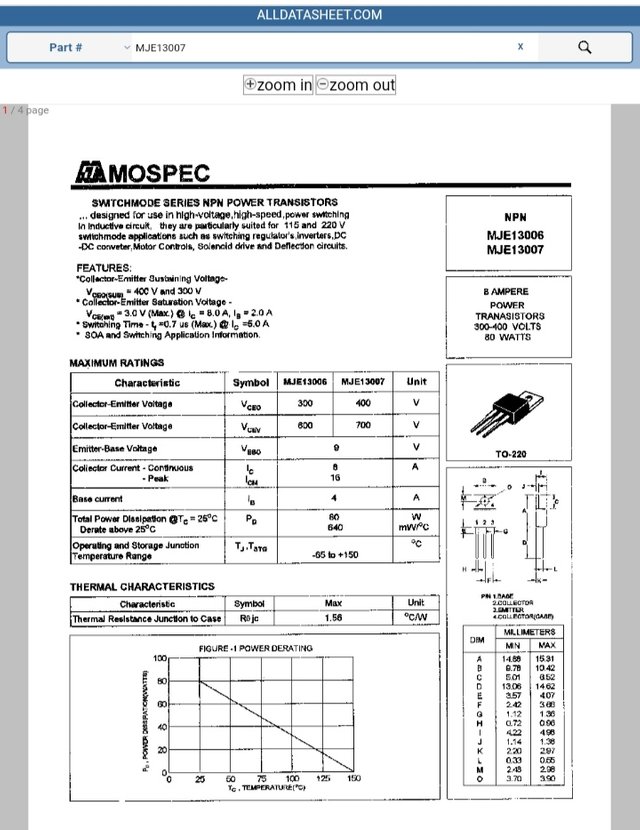
Con esta clase tenemos la oportunidad de aprender a medir y detectar transistores dañados, desvalorizados o con fuga. Cuando existen sobre voltajes en un circuito es muy probable que los transistores sufran y empiecen a fallar. Así que descartar estas fallas puede ser la solución a ese problema que presenta el artefacto en tus manos.
0.00 SBD,
0.10 STEEM,
0.10 SP,
0.00 TRX